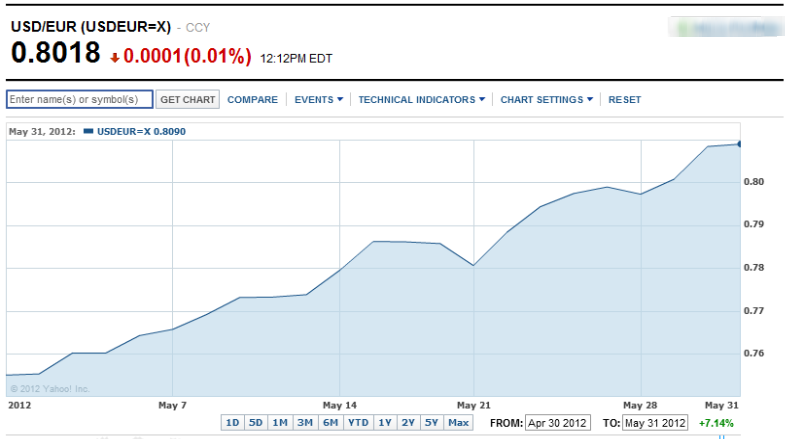Selling software to a global audience requires powerful vision and strategic flexibility. In addition to localizing payment methods, languages and marketing speak, ecommerce managers must also monitor price points across their global markets.
Let’s say that you’ve set customer friendly prices in local currencies, and your system routes customers to prevent them from currency shopping. An equally important topic to consider as part of an on-going pricing strategy is your foreign currency pricing.
Depending on your base currency, a fluctuating exchange rate may be a problem or it may be an opportunity for unexpected cash.
In order to plan strategically you need to decide between two questions: “Do I want to be paid the same amount for my product in foreign currencies?” or, “Am I looking to price my product according to what the market will bear?”
With the former strategy, you know exactly how much you will earn in your home currency for each sale. With the latter, your product will either be priced higher or lower than your domestic price.
What is your best option?
If you followed our introduction to Japanese ecommerce, you learned that Symantec prices their flagship product at $99.95 in the US. Since the rate of Japanese Yen to US Dollar is about 70:1, the price in Japan should be approximately 700¥. Yet, the product in Japan is priced at nearly 2,000¥.
Why?
Well, the Japanese market bears a much higher price, so a company that enters the Japanese market with a 700¥ price is potentially leaving money on the table. Also, it’s possible that such a low price indicates an inferior product to consumers.
Pretend, though, that the scenario were reversed and the market will bear 700¥, but the exchange rate suggests a price of 2,000¥. What are the chances that your product priced at 2,000¥ will be successful when the market price for such a product is only 700¥? Don’t stake your career on this line of thought.
The importance of your foreign market pricing strategy is clear. But choosing a price point for your product is only the beginning of this challenge. You must now monitor currency fluctuations. The image below shows how the U.S. dollar grew stronger relative to the euro from April 30th, 2012 to May 31st 2012.

Now imagine that you are a US company and your product’s base price is $50. You sell to Europeans, so when Europeans visit your site, you route them to a cart with the product priced in euros. If your strategy is to do strict currency exchange, on April 30 a converting visitor pays you 40.45€ and a converting visitor on May 31 pays you 37.76€, representing a 6.66% difference. In both circumstances you have earned $50 (See Figure 2).
|
Product Price (USD) |
Date of Exchange Rate |
USD to EUR Exchange Rate |
Product Price (EUR) |
|
$50 |
April 30 |
.8090 |
40.45€ |
|
$50 |
May 31 |
.7551 |
37.76€ |
Fig. 2
There are a couple risks present in this scenario. First, customers are seeing different prices on different days. Even though US consumers pay the same price on April 30 and May 31, Europeans buying on April 30 will pay more than those buying on May 31. This discrepancy may increase customer contacts and refund requests. Second, a price based on a strict currency conversion may not play well in that market which affects your conversion rates.
Based on these risks, perhaps you’ve decided on a set price for European customers, regardless of currency fluctuations. In the scenario outlined in Figure 2, a product priced at 40€ will earn you $49.44 on April 30, but $52.97 on May 31.
|
Product Price (EUR) |
Date of Exchange Rate |
USD to EUR Exchange Rate |
Product Price (USD) |
|
40€ |
April 30 |
.8090 |
$49.44 |
|
40€ |
May 31 |
.7551 |
$52.97 |
Fig. 3
If your product price was fixed at 40€ while the exchange rate was fluctuating, you would receive an extra $3.53 since the USD strengthened during May. On the surface the fluctuation works to your advantage because you now have more dollars.
But if we flip the scenario and consider that the dollar weakened relative to the euro from May 31 to April 30, you would have received $3.53 less than previously earned. This may not seem like a lot of money, but multiply this over the hundreds and thousands of orders every month and it adds up.
These fluctuations offer an opportunity for taking an unexpected revenue increase to see if your product’s price is elastic. First, it’s important to set prices in marketing friendly foreign currencies. Let’s stick with a product priced regionally at $50 and 40€. As the currency changes, your customers paying in those currencies don’t see any difference, but you do in the amount of money that you receive.
If you receive an extra $3.53 because of your home currency strengthening , this puts an extra 6.66% at your disposal and you can either drop your price 6.66% and see if there is a noticeable increase in sales, or leave your price the same and promote a 6.66% discount in a marketing campaign and see if this results in meaningful sales. In either case, you will gain insight into how willing your customers are to buy your product at different prices.
Opportunities like this usually present themselves once or twice a year, if at all. Pay attention to current events like the recent Greece debt crisis. They usually indicate that you should look at your product prices.
Keystone
Wild swings in foreign exchange rates provide an opportunity to test your product’s price elasticity.